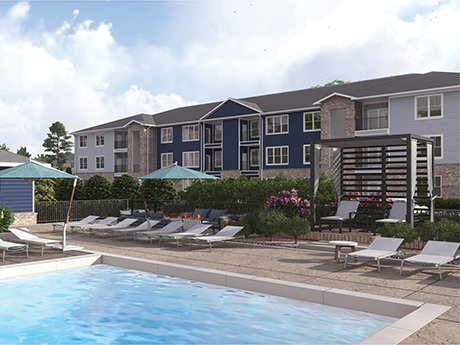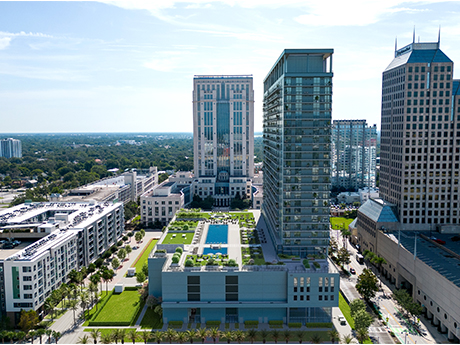Despite healthy local market dynamics, the greater New Orleans industrial market did not perform as strongly as insiders expected it to perform over the past 12 months, which is indicative of wider economic factors suppressing a market with pent-up demand. The Port of New Orleans and its access to major shipping routes along the Mississippi River has long been the principal component for industrial real estate in the area. The recent 2024 regular session of the Louisiana Legislature committed $230.5 million to Port of New Orleans infrastructure projects, including allocations to the Louisiana International Terminal, a $1.8 billion project in Violet, La., scheduled to be operational in 2028, which will be the Gulf South’s premier container shipping gateway able to accommodate New Panamax- and Post New Panamax-sized vessels. A bit further up the Mississippi River but still in the greater New Orleans region, Canadian company Woodland Biofuels announced a $1.35 billion investment at the Port of South Louisiana in Reserve, La., to establish the largest renewable natural gas plant in the world. The facility will take waste wood and sugar cane and turn it into natural gas. The process will be carbon-negative, leaving less carbon in the atmosphere than before …
Southeast Market Reports
A combination of short sales, declining occupancy rates, loan concerns and migration to suburban offices contribute to uncertainty in the New Orleans office market. As we approach the fourth quarter of this year and begin to reflect back on the market in 2024, the challenges unfortunately outweigh the opportunities. Two notable cases include The DXC Technology Center and The Energy Centre. The DXC Technology Center, located at 1615 Poydras St. in the Central Business District (CBD), a once-prized office tower anchored by Freeport McMoRan, sold for less than $37 per square foot. The building, over 500,000 square feet, traded for $18.5 million, significantly below the remaining debt on the property. The New Orleans Police Department recently signed a lease to occupy approximately 45,000 square feet in the building, which lessens the steep decline in the building’s value. The Energy Centre, located at 1100 Poydras St., is one of the most desirable and best-performing Class A towers in the CBD. It entered receivership, but the building is back on track and is rumored to be nearing a sale. The building owner, The Hertz Group, controls four additional Class A office towers on Poydras St. (400, 650, 701 & 909 Poydras St.), …
Amidst economic uncertainty, Louisville stands out for its resilience, establishing itself as a stalwart in today’s market. According to Apartments.com, Louisville ranked No. 1 in the nation for rent growth in the second quarter of 2024. Factors such as Louisville’s non-cyclical job growth, expanding industries including EV production and the burgeoning River Ridge project in Southern Indiana all contribute to its growth. When we inspect the data, we see a basic yet fundamental market factor at play: supply and demand. Louisville’s supply is low relative to the growth in renters, resulting in upward pressure on rents despite a nationwide market that is largely declining. Supply dynamics The bulk of Louisville’s development pipeline is concentrated in Southern Indiana, with 1,039 units under construction in the Jeffersonville submarket. The Southern Indiana region has experienced solid growth with over 10,500 incoming jobs due to the economic activity from River Ridge. River Ridge Commerce Center reported an economic impact of $2.93 billion for calendar year 2023, up over $2.7 billion compared with 2022, according to Inside INdiana Business. Notable development projects in Southern Indiana include: • The Flats on 10th, 3300 Schosser Farm Way (300-units by Schuler Bauer Real Estate) • The Warren, 4501 …
The Louisville office market is at an interesting crossroads, to say the least. Historically, the sector has always skewed toward the suburban submarkets as east Jefferson County has been the go-to area for companies looking for office space. Over the past few years, the shift to the suburbs has become more pronounced than ever as Louisville’s office market experiences a dramatic contrast between the current state of the overall office market in the suburbs versus the central business district (CBD). In the suburban markets, the premier office buildings are experiencing low vacancy rates and record-setting growth in rental rates. On the opposite side, the CBD continues to struggle with increases in vacancy rates, which is expected to increase in the coming months. This trend reflects overall national office trends as companies focus on new, highly amenitized spaces to offer their employees. Suburban Louisville The suburban office market in Louisville has demonstrated reliable stability over the past four years. As of second-quarter 2024, the vacancy rate for Class A spaces stood at 12.7 percent, while Class B spaces recorded a higher rate of 17.2 percent. The suburban market has seen limited new construction deliveries thus far in 2024. The most notable …
Louisville’s economy remains resilient, and regional economic growth is creating a strong foundation for the retail market. Greater Louisville Inc. recently announced that 72 businesses are considering relocating or expanding to the region, with the potential of 8,200 new jobs and $3.8 billion in economic investment. Louisville is well-positioned for growth and the retail outlook remains strong with historically low vacancy rates. The market’s expanding consumer base and resilient economy have mostly overcome headwinds such as interest rate fluctuations, volatility in capital markets and signs of a slowing economy. This resilience has put Louisville in a strong position moving into the last quarter of 2024. At the end of the second quarter, Louisville’s vacancy rate stood at a strong 3.4 percent, outperforming the national benchmark of 4.1 percent, according to CoStar Group. The limited amount of new retail construction over the past 18 months has played a significant role in keeping the vacancy rate low. In fact, only roughly 322,000 square feet of retail space has been delivered over the past 12 months. Grocers are pushing leasing activity, making up 36 percent of the leasing volume that past 12 months. These retailers are executing most of the activity in spaces …
FloridaGeorgiaMarket ReportsNorth CarolinaSouth CarolinaSoutheastSoutheast Market ReportsStudent Housing
Universities, Student Housing Properties in Southeast Contend with Hurricane Helene
by John Nelson
Hurricane Helene made landfall in Northwestern Florida on Thursday, Sept. 26, after being upgraded to a major Category 3 storm that afternoon. Widespread damage across a number of Southeastern states followed in its wake, with many areas experiencing flooding, downed trees, power outages and road closures. At least 175 people have died across six states, according to reports by CNN and The New York Times, and officials fear that the death toll is likely to rise with many remaining missing. Hundreds of roads remain closed across the Southeast — especially in Western North Carolina and East Tennessee, which were hit particularly hard by the hurricane — hampering the delivery of supplies, and more than 2 million customers remain without power. Student Housing Business reached out to universities, owners, operators and students across the Southeast to check in on how they fared during the storm and their experience in the aftermath. Owners, Operators Weigh In Denver-based Cardinal Group tracked its communities in Alabama, Arkansas, Florida, Georgia, Kentucky, North Carolina, South Carolina, Tennessee, Virginia and West Virginia through Hurricane Helene. “Of those communities, four experienced power outages and several had minor roof leaks and flooding, with the largest impact felt in Asheville and Boone, North Carolina,” says Jenn Cassidy, president of property operations …
Louisville’s Industrial Market Is Entering ‘Slow-Paced Cooldown’ Period of Market Cycle
by John Nelson
The Louisville industrial market has simmered at a slow and steady pace during 2024. Continued uncertainty with debt markets, inflation and the upcoming elections have placed developers on the sidelines, and occupiers in a holding pattern. Despite how the market feels today, Louisville remains poised for a comeback. A brief overview shows how and why the Louisville market is in the position it is today, and what to expect beyond 2024. The past five years reveal a compelling story, one that developers, occupiers and investors alike have come to understand as they seek to develop, lease or own real estate in the Derby City. Driving much of this development and occupier activity in Louisville is the presence of the UPS Worldport, two Ford manufacturing plants, Haier’s GE Appliance Park and other manufacturers that keep suppliers, third-party logistics firms and e-commerce companies jockeying for space. Louisville’s central location on the I-65 corridor and proximity to two-thirds of the U.S. population are also key reasons the market continues to grow as a hub for logistics, e-commerce and manufacturing. The market saw tremendous growth over the past five years, assisted by the space grab during COVID. Since 2019 bulk inventory experienced growth of …
Orlando’s multifamily market has experienced softened conditions lately due to a record amount of new supply being built, as well as economic challenges impacting commercial real estate as a whole. Yet, green shoots have emerged as insurance costs continue to ease and interest rates remain steady with downward pressure. Both overall sentiment and renter demand have steadily improved as well. Properties in the multifamily space seeing the most interest these days are those that are high-quality and well-located. Two key multifamily sale transactions that occurred in the second quarter of 2024 were in the Southwest Orlando submarket. This includes the 424-unit Osprey Links at Hunter’s Creek property that sold for $100.6 million, which marked Orlando’s largest multifamily sale this year, and the 296-unit Sonceto Apartments property that sold for $71 million. Investors are flooding back into the market with increasingly more aggressive offers and heightened competition as a result of the still limited available multifamily inventory and notion that supply levels have peaked. However, additional supply will still enter the market in the years to come as developers maintain a positive outlook on Orlando with just over 2,000 units across six buildings delivered by the end of the second quarter …
The commercial real estate market, particularly in the retail leasing sector, has been navigating a complex and dynamic landscape over the past few years. With a blend of high demand, limited supply and fluctuating economic variables, the Orlando market presents both challenges and opportunities for developers, landlords and tenants alike. High demand, limited supply One of the most prominent trends in the Orlando retail leasing market is the high demand for quality retail spaces. Retailers are eager to establish and expand their presence in this thriving market, driven by a growing population and increasing consumer spending. However, the inventory of quality existing retail bays is incredibly scarce. This scarcity has created a competitive environment where desirable locations are quickly snapped up, often at premium prices. The supply-demand imbalance has pushed developers to sharpen their pencils and critically analyze the feasibility of new projects. Despite the strong demand, many deals struggle to pencil out due to the high costs of construction materials and labor. These costs have remained elevated, making it challenging for developers to achieve a satisfactory return on investment. As a result, some projects are delayed or shelved, further constraining the supply of retail space. Housing spurs development The …
Orlando’s industrial market has enjoyed consistently low vacancy, robust new development and significant rent growth year after year since the onset of the pandemic. While fundamentals remain strong, project deliveries and changing size preferences for leased space have caused a shift in activity. From an economic perspective, Orlando is well-positioned. The unemployment rate has decreased by 30 basis points since first-quarter 2024, reaching 2.9 percent, notably lower than the national average of 4.3 percent. Over the past year, nonfarm employment has grown by 1.4 percent with construction employment seeing a significant increase of 2.9 percent during the same period. Small to mid-sized spaces For the past 20 consecutive quarters, Orlando has maintained positive net absorption. Small bay and other tenants under 200,000 square feet have dominated leasing activity, while demand for spaces over 200,000 square feet has significantly slowed. As a result, year-to-date absorption is just over 800,000 square feet, representing a 40.8 percent decrease compared to 2023’s midyear total and the lowest midyear total since 2020. This slowdown in absorption is accompanied by a rise in vacancy rates, which have increased by 1 percent since last year and 3 percent since 2022. ATR Commercial Flooring took 150,600 square feet …










